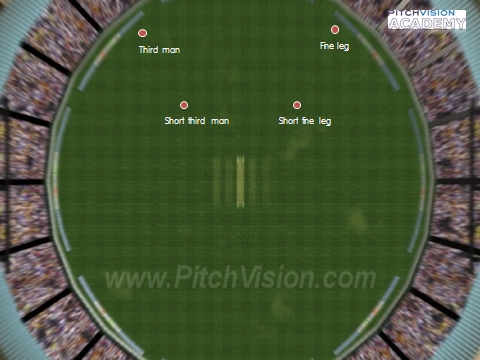Specialist fielding: Fine leg and third man
This is part of the specialist fielding series of articles, for the full list of fielding positions covered click here.
OK I admit it. There are no specialist fine leg fielders. But in most teams it’s the same players who end up at either fine leg or third man, usually a bowler.
For that reason it makes sense to practice the skills you will most need.
Why have third man and fine leg?
Both positions are placed behind square. Third man is on the off side, fine leg (sometimes called long leg), as you can guess from the name is on the leg side.
As the batsman will largely be playing straight your main job is to stop the ball that is edged towards you from straight bat shots and return it to the wicketkeeper.
To faster bowlers you will find yourself all the way on the rope and you will simply be aiming to prevent the boundary and get the ball in, giving up 1 or 2 runs along the way. The odd catch may come your way from a hook or flying edge.
Traditionally the fast bowler’s get dispatched there to ‘graze’; think about his or her bowling and return the odd ball with languid disinterest. These days’ expectations are higher with accurate throws, diving catches and sliding stops all de rigueur.
Spinners, slower medium pacers and faster bowlers trying to get around field restrictions will bring you up to a ‘saving one’ position in the circle. Here you are trying to stop the single being taken. You are also more likely to take a catch; for example from a top-edged sweep.

How to field at fine leg
When you are fielding on the boundary you have a lot of time when the ball is either not coming to you, or coming slowly so you don’t need to anticipate or focus too hard. This is why it’s great for bowler to reflect and plan between overs.
That said a good fine leg and third man fielder needs to be able to attack the ball even when it is coming slowly, then throw flat and hard to the keeper. Alert batsmen who see a weak arm from the boundary will nick another run.
You also need to be able to cover a lot of ground running around the boundary and putting in a dive to stop a boundary. Catches that come to you will often require you to take them running or even diving forward.
When you are up saving one you become a ring fielder. Anticipation becomes more important. Watch the batsman more closely for when he is shaping to drive (third man) or goes back to play through the leg side (fine leg) and get ready to move quickly the moment you pick up the ball off the bat.
Ways to practice
Apart from the same drills as a ring fielder, fine leg and third man should also work hard on learning how to dive to stop or catch the ball and how to throw a cricket ball hard and flat. The techniques are safe if you learn how to do them properly.
Once you have the technique right, drill as often as you can to get it right. Here are some example drills for the skills you need:
Finally, don’t ignore the importance of working on your running speed. An extra bit of pace through good technique and regular training can save a lot of runs over a season.
- Login to post comments


Comments
recently I have assigned to the short third man position (feel like a slips position but slightly deeper) and a lot of times I find it different to field because the batsmen plays these shots very late and usually there is spin imparted on their batting to the ball.
A lot of times I put my weight into the wrong leg because I anticipate the ball to travel to me to my left or right and resulting in a misfield.
How can I get over that in terms of alertness and attention.
Is there something I can read from the ball which will tell me whether it will spin left or right?
sorry some serious typo in there. different should had been difficult and also I have been assigned and not I have assigned